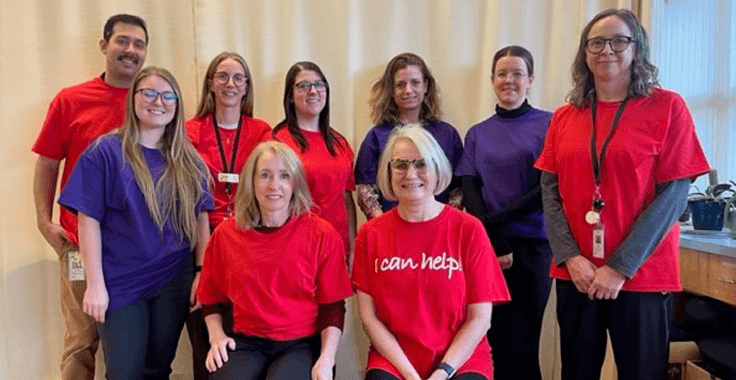Stop pressure injuries and improve patient safety, national awareness day: Nov 16
Evidence-based checklist to prevent skin harm and pressure injuries

By Lindsay MacKenzie
Winnipeg Regional Health Authority
Published Wednesday, November 15, 2023
A new care bundle has been developed that will give health care staff in the Winnipeg health region evidence-based intervention tools to help reduce the harm associated with pressure injuries. The team responsible for implementing the new tool called a SSKIN care bundle is using national pressure injury prevention day on November 16 to kick off awareness.
"I’d say mainly our direct service support workers, healthcare attendants and nurses are looking at these interventions across all of our sectors. It’s not meant to be a replacement or new policy. It's meant to underpin work already being done," said Isabelle Jarrin, manager of patient safety for the WRHA and co-lead of the pressure injury prevention strategy.
The care bundle name is an acronym that stands for five different groups of interventions to prevent harm to skin and tissues while a patient, client or resident is in care:
- Skin Assessment & Skin Care
- Support Surfaces & Offloading
- Keep Moving - Redistribute Pressure
- Incontinence & Moisture Management
- Nutrition - Optimize Nutrition & Hydration
"What we’re really talking about is the importance of prevention and using universal strategy," said Jane McSwiggan, the WRHA education and resource coordinator for wound care and co-lead with Jarrin on the pressure injury prevention strategy.
Since 2006, the province of Manitoba has had legislation for mandatory no-blame critical incident reporting across the health system, which makes spotting areas for improvement in care delivery more transparent. "It's always been on our radar," said McSwiggan who explained that pressure injuries typically have the highest occurrences in patient safety reports for the region.
The project team is trying to reduce the number of harm-related pressure injuries reported and wants care teams to use the SSKIN care bundle as part of protocols they already follow.
"Assessment of risk for skin injury is an expectation upon admission or starting of services," according to Isabelle Jarrin, who is co-leading the strategy stemming from the WRHA's annual operating plan. In health care settings such as long-term care, community health, in-patient medicine units or acute care there are interventions that would be applied based on the level of risk found during the assessment process.
"Everyone in our care is at risk for pressure injuries from very young to very old," said McSwiggan.
Once the assessment is completed, it is documented and then interventions are applied based on the level of risk identified. The goal of the pressure injury project team is to standardize prevention methods and provide wound care resources across the WRHA.
"We talk about occurrences of skin harm or tissue harm in stages," said McSwiggan, "we shouldn't discount stages one and two because every stage four, which has the potential to be a pressure injury critical incident, started as a stage one."
How do I stage pressure injuries to prevent harm?
Pressure injuries can occur when patients, clients or residents are receiving care people and health care staff need to know how to accurately categorize skin injuries based on the level of harm or damage to the tissue when they are noticed during assessments. Pressure injuries are staged from 1-4, and unstageable, when the base of the wound cannot be seen. There are categories for deep tissue injury and mucosal membrane pressure injury as well.
What training and education materials are available?
Prevention strategies include frequent monitoring of skin integrity and actions such as turning, repositioning, improving nutrition and skin care. These are important activities to address harm to tissue before it progresses to a more serious issue. However, the path to reducing pressure injuries is two-fold according to McSwiggan and Jarrin. Education and training are other important components to supporting health care staff in the region work towards the goal of reducing critical incidents caused by pressure wounds.
"A new SSKIN care bundle poster will have the acronym and intervention prompts as well as a link to the Wound Care intranet website where more resources can be found," said Jarrin. "Safety huddles taking place at WRHA sites and facilities will incorporate conversations about skin care, skin assessments and pressure injury prevention as well."
There will also be a supplemental implementation guide for managers. This document is intended to provide guidance to managers on how to support direct care staff in using the SSKIN care bundle to help their teams prevent pressure injuries. A new LMS course will be released in early 2024 for staff as well, which will have more specifics about staging pressure injuries.
Jarrin hopes that the SSKIN bundle will be used by staff in a variety of different care settings. "It's about reaffirming what we're doing and how we're going to get the word out there so [the care bundle] becomes a common application."
